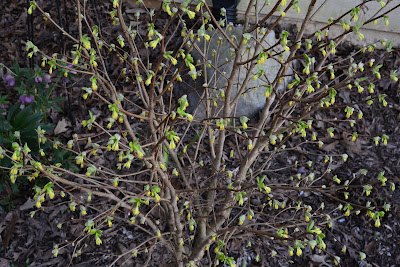Wildflower Wednesday: Dirca palustris
This native shrub, sits at the bottom of a significant slope between the back of our house and the wildlife pond. Water tends to pool here during periods of heavy rain making it the perfect plant for this site.
Known as [eastern] leatherwood, it is found in the forest understory from the eastern coast of Maine to Florida and into the Midwest of the United States (see map). It is a shrub that indicates an old growth forest, of which there are few remaining, making it an uncommon find in its natural habitat.
The botanical genus comes from the Greek word dirke, meaning fountain. This is a reference to the boggy habitat this shrub prefers to grow in.
I picked this shrub up about 8 years ago from a native plant vendor at a symposium. It is the earliest blooming native shrub in our garden and has performed very reliably, flowering each February/March. The quaint tubular flowers appear first followed by leaf out. You can see in the photo below that youngest leaves are hairy.
At maturity it reached about 3-6 feet but is extremely slow growing.
When the bloom period is over it becomes a nice anchor for other plants in this area. I have a variety of native ferns that develop fronds just when the leatherwood finishes blooming.
The bark has a gorgeous golden hue which is attractive during the months when it stands bare. Interestingly, the bark is extremely flexible. One can bend a branch easily without breaking it. The twigs and bark were used for making baskets, bow strings and fishing line by Native Americans. Some people can have a reaction to the bark. The roots, fruit and bark are all toxic so be warned.
This is not a common plant in the nursery trade but you may find it at a native plant nursery or native plant sale. If you can get your hands on one of these shrubs, plant it along a creek bed, pond margin or area that retains moisture. Preferably somewhere you will frequent in spring so you can enjoy its early blooms.
I'm joining Clay and Limestone, our illustrious host, for Wildflower Wednesday. Be sure to check out what other fabulous wildflowers bloggers are sharing.
Known as [eastern] leatherwood, it is found in the forest understory from the eastern coast of Maine to Florida and into the Midwest of the United States (see map). It is a shrub that indicates an old growth forest, of which there are few remaining, making it an uncommon find in its natural habitat.
The botanical genus comes from the Greek word dirke, meaning fountain. This is a reference to the boggy habitat this shrub prefers to grow in.
I picked this shrub up about 8 years ago from a native plant vendor at a symposium. It is the earliest blooming native shrub in our garden and has performed very reliably, flowering each February/March. The quaint tubular flowers appear first followed by leaf out. You can see in the photo below that youngest leaves are hairy.
At maturity it reached about 3-6 feet but is extremely slow growing.
When the bloom period is over it becomes a nice anchor for other plants in this area. I have a variety of native ferns that develop fronds just when the leatherwood finishes blooming.
The bark has a gorgeous golden hue which is attractive during the months when it stands bare. Interestingly, the bark is extremely flexible. One can bend a branch easily without breaking it. The twigs and bark were used for making baskets, bow strings and fishing line by Native Americans. Some people can have a reaction to the bark. The roots, fruit and bark are all toxic so be warned.
This is not a common plant in the nursery trade but you may find it at a native plant nursery or native plant sale. If you can get your hands on one of these shrubs, plant it along a creek bed, pond margin or area that retains moisture. Preferably somewhere you will frequent in spring so you can enjoy its early blooms.
I'm joining Clay and Limestone, our illustrious host, for Wildflower Wednesday. Be sure to check out what other fabulous wildflowers bloggers are sharing.







